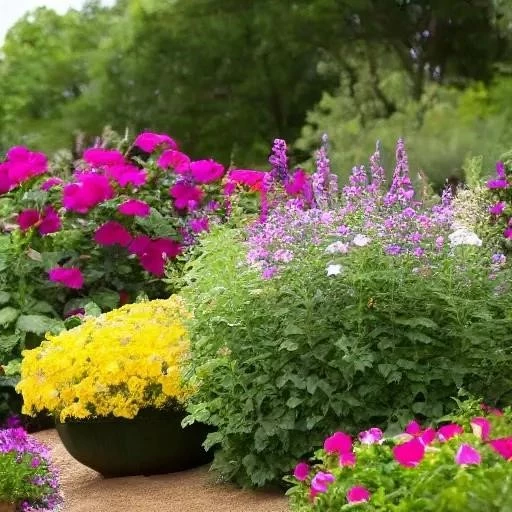
In countless kitchens worldwide‚ a humble white powder sits‚ quietly awaiting its call to action. From leavening cakes to deodorizing refrigerators‚ baking soda – or sodium bicarbonate – is celebrated for its versatility and gentle efficacy. Its widespread use often leads curious gardeners to ponder its potential beyond culinary and cleaning exploits. Could this household staple‚ so benign in our homes‚ also offer a miraculous solution or‚ conversely‚ pose an unforeseen threat to our vibrant flower gardens?
This question‚ echoing through gardening forums and whispered among green-thumbed enthusiasts‚ delves into the intricate biochemistry of soil and plant health. While the allure of an inexpensive‚ readily available garden aid is undeniably strong‚ understanding the nuanced interactions between this common compound and delicate flora is paramount. We’re embarking on a journey to uncover the scientific truths‚ separating myth from reality‚ to ensure your cherished blooms continue to thrive‚ unmarred by well-intentioned but potentially misguided applications.
Understanding Baking Soda’s Garden Impact: A Quick Guide
| Aspect | Description | Key Considerations |
|---|---|---|
| Common Garden Uses | Often suggested as a mild fungicide (e.g.‚ powdery mildew) or a repellent for certain soft-bodied insects (e.g.‚ aphids) when diluted. Some also use it to sweeten tomatoes‚ though scientific evidence for this is limited. | Usually applied as a foliar spray; effectiveness varies widely depending on the specific pest or disease. |
| Potential Risks & Harm | High concentrations can cause leaf burn (scorching)‚ especially in direct sunlight. Direct application to soil can significantly alter pH‚ making it too alkaline for most flowers. Sodium buildup can lead to toxicity‚ inhibiting water absorption and stunting growth. | Risk increases with frequency‚ concentration‚ and direct soil contact. Sensitive plants are particularly vulnerable. |
| Best Practices for Application | Always dilute extensively (e.g.‚ 1 teaspoon per quart of water with a drop of horticultural soap). Test on a small‚ inconspicuous area of the plant first. Avoid spraying during the hottest part of the day. Do not apply directly to soil around acid-loving plants. | Moderation and careful observation are crucial. Consider it a short-term‚ experimental solution rather than a staple. |
| Recommended Alternatives | For fungal issues‚ consider neem oil‚ horticultural oil‚ or improving air circulation; For pests‚ insecticidal soaps‚ beneficial insects‚ or manual removal are often safer. Soil pH adjustments should be done with organic matter (compost) or specific amendments (e.g.‚ sulfur for acidity‚ lime for alkalinity) based on professional soil tests. | Focus on integrated pest management and holistic soil health for long-term success. |
At its core‚ sodium bicarbonate is an alkaline salt. Introducing it into the garden directly impacts the delicate pH balance of the soil‚ a crucial factor governing nutrient availability and microbial activity. Most flowering plants prefer a slightly acidic to neutral soil (pH 6.0-7.0)‚ and a significant shift towards alkalinity can stress roots‚ impeding their ability to absorb essential nutrients like iron and manganese. This fundamental chemical reaction‚ often overlooked by enthusiastic DIY gardeners‚ underscores the need for caution. Understanding this underlying principle is paramount for safeguarding your garden’s vitality.
Despite these chemical realities‚ baking soda has garnered a reputation as a natural fungicide‚ particularly against powdery mildew. When mixed with water and a tiny amount of horticultural soap‚ it’s believed to create an environment on leaf surfaces that inhibits fungal spore growth. This method‚ while sometimes showing remarkably effective results in controlled‚ mild outbreaks‚ isn’t a universal panacea. Its efficacy is often plant-specific and dependent on the severity of the infection‚ highlighting the importance of targeted application rather than broad-spectrum treatment. Experimenting with caution can be illuminating.
However‚ the very properties that give baking soda its perceived power also contain its potential for peril. The “sodium” in sodium bicarbonate is the primary concern for plants. Excessive sodium in the soil can lead to salt toxicity‚ making it difficult for plants to absorb water‚ even when available – a phenomenon akin to drought stress. Furthermore‚ a concentrated baking soda solution‚ especially when applied to foliage under the intense glare of the midday sun‚ can act as a desiccant‚ literally burning leaves and causing unsightly‚ irreversible damage. Witnessing these scorched leaves can be heartbreaking for any dedicated gardener.
Horticultural experts consistently advise extreme prudence when considering baking soda for garden use. “While baking soda might offer a temporary fix for specific issues like powdery mildew‚ it’s a blunt instrument in a gardener’s delicate toolbox‚” explains Dr. Elaine Peterson‚ a renowned plant pathologist. “Its risks‚ particularly concerning soil health and sodium buildup‚ often outweigh its limited benefits. We always advocate for integrated pest management and soil testing as foundational practices.” By integrating insights from AI-driven agricultural analyses and traditional wisdom‚ modern gardening increasingly prioritizes sustainable‚ long-term solutions over quick fixes. Responsible application‚ meaning highly diluted sprays on affected foliage only‚ and never directly onto the soil‚ is the only recommended approach‚ and even then‚ patch testing is crucial.
Ultimately‚ the question of whether baking soda harms your flower garden isn’t a simple yes or no; it’s a resounding “it depends.” Used carelessly‚ it undoubtedly can. Applied with extreme caution and in very specific‚ limited scenarios‚ it might offer a minor‚ temporary benefit. The future of gardening‚ however‚ belongs to informed‚ holistic practices. Opting for proven organic fungicides‚ ensuring proper air circulation‚ cultivating rich‚ balanced soil‚ and selecting disease-resistant plant varieties are incredibly effective strategies that truly foster a thriving‚ resilient floral paradise. Let us move forward‚ armed with knowledge‚ cultivating not just beautiful flowers‚ but also sustainable‚ vibrant ecosystems for generations to come.
